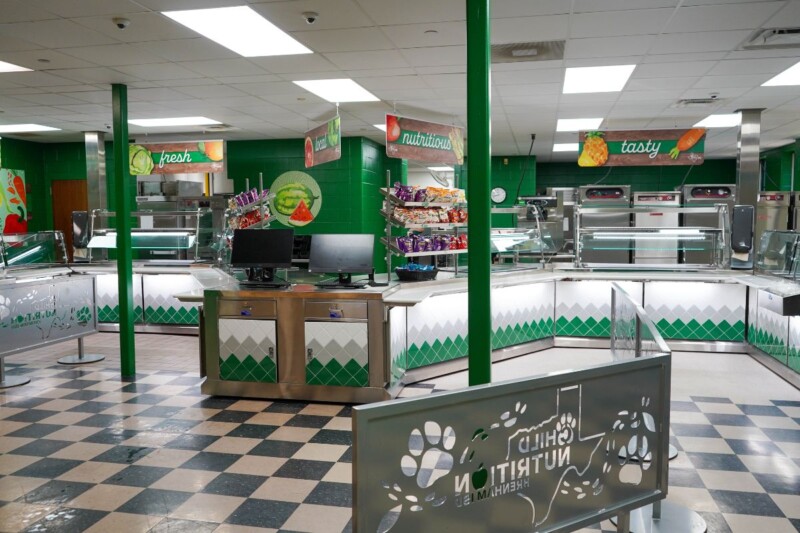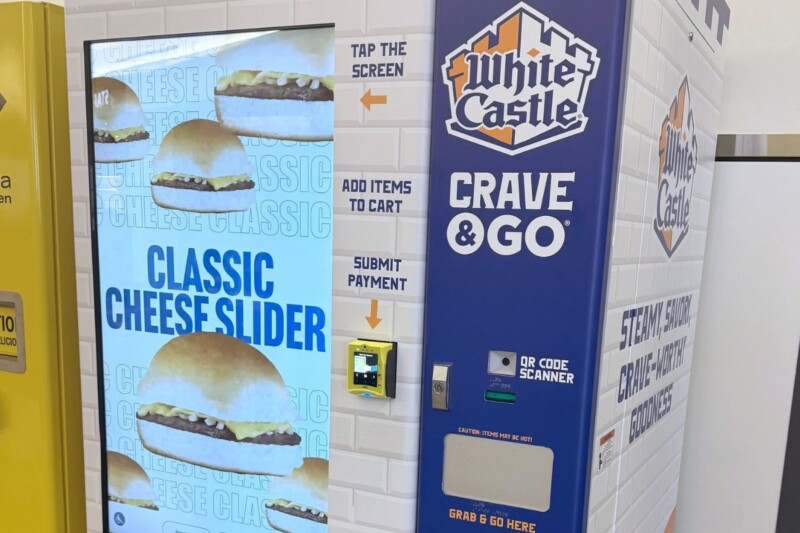Asian foods—from Peking duck to sushi to ramen to steamed dumplings—usually require unique ingredients, a skilled cook and the right equipment for authentic results. Most restaurants will choose to specialize, doing just sushi, or just dim sum.
But at Morimoto Asia, the stunning new pan-Asian restaurant in Disney Springs, Lake Buena Vista, Fla., founder “Iron Chef” Masaharu Morimoto brings it all to the table flawlessly with cooking equipment influenced by kitchens found in China, Japan, Korea and Thailand.
The 474-seat pan-Asian eatery that debuted Sept. 30, 2015, is a joint project between Morimoto and Patina Restaurant Group, New York.
The restaurant occupies a former bottling plant. Interior designers Studio V Architecture, New York, transformed the space’s gritty industrial shell with translucent light installations made of illuminated glass beads suspended from the ceiling, a triple-height wall of windows and a white, ribbon-like, 270-ft.-long sculptural bar made of Corian that starts at the maître d’ desk on the main floor and flows up a grand stairway to the mezzanine-level lounge and bar. Japanese accents in the form of contemporary black-and-white prints, Japanese calligraphy and Asian woods and fabrics complete the look. The focal point of the main dining room is the busy cookline with wok chefs working in a blur of motion. Front and center stands a four-ft.-sq., order-inducing display case of Peking ducks.
The Morimoto Asia kitchen combines the right equipment to efficiently execute five distinct Asian cuisine styles in Disney’s high-traffic volumes. Its menu ranges from Peking duck and ramen noodles to moo shu pork, sweet/sour crispy whole fish and everything (Asian) in between. Dim sum, served during weekend brunches, includes dumplings, shumai, bao and spare ribs. Sushi and sashimi are crafted at a mezzanine-level, 14-seat sushi bar. “Street food” is served at a side window.
“Shortly after the restaurant opened, Patina Executive Chef Lou Piuggi told me he had thought the kitchen might be too big,” says lead kitchen designer Jimi Yui, YuiDesign Inc., Takoma Park, Md. “But after the very first Saturday night service where the restaurant did 1,200 dinner covers, he said, ‘now I’m going to gripe because there aren’t enough walk-in boxes!’
“Morimoto Asia’s food is high-end cuisine,” Yui adds. “To produce it, in such volume and so quickly out of the gate, speaks to the culinary team’s commitment. Such a broad menu requires a lot from each station, so that dumplings are perfectly steamed and the duck is crispy, every single time. That’s the hard part. But they’re doing it.”
Team Morimoto Asia
The design team was led by Chef Morimoto, along with his right-hand men, Corp. Chef Takao Iinuma and Operations Director Michael Welch, Morimoto Management, along with Yui. They collaborated with Patina Project Development V.P. Robert Consla and Executive Chef Piuggi.
Starting in early ’14, the team explored various kitchen ideas. The real design work launched in September of that year. Disney’s fast-track schedule led to construction that began in December. By spring ’15, kitchen equipment began arriving. “We were drawing and building at the same time,” Yui says. The restaurant opened on Sept. 30, ’15.
Peking Duck By The Numbers
Quality, variety and volume served as the guiding design principles for Morimoto Asia’s kitchen. The first puzzle was how to menu Peking duck in Disney-worthy volumes.
“From the very beginning of the project, Chef Morimoto wanted to include great, and affordable, Peking duck on the menu,” says Yui, for whom Morimoto Asia marks his twelfth collaboration with the Japanese restaurateur. “Peking duck preparation requires at least two days: drying the ducks, inflating the skin, roasting, then slicing and dressing,” Yui continues. “We knew the restaurant would have about 150 tables, with a dinner rush two or three turns per night. If, say, 60 tables ordered duck per seating, we had to be ready to serve nearly 200 ducks a night.”
The kitchen began to take shape around Peking duck prep requirements. “We dedicated one of the four walk-in coolers to duck drying,” Yui says. “When we learned high-end Chinese chefs were using combi ovens to bake the birds, we specified a pair of full-size Rational units able to accept roll-in racks that hold up to 18 birds at once. We ordered extra racks for easier in-and-outs.
“To showcase the finished ducks, we had a heated display case fabricated by RPI Industries, to hold two rows on hanger rods, placed in full view of the dining room,” Yui says. “Morimoto has one cook dedicated to Peking duck’s final preparation, with all the side ingredients—pancakes, scallions, apricot sweet chili, hoisin miso and cucumber. As people move through the dining room, they see him working and want to order Peking duck for their own table. That’s a $48 dish.”
The Morimoto Asia kitchen also had to be prepared to handle high volumes of dim sum, ramen noodles and stir-fry dishes as well as Chef’s special entrees that could be prepared on a standard cookline.
Dim sum cooks traditionally use two-ft.-diameter bamboo baskets on wok steamers. “Clouds of steam billow out whenever you lift the lids” says Yui, who grew up working in Chinese restaurant kitchens. “They’re not easy to use, and the timing is always tricky.”
Instead of a massive steamer wok, Morimoto Asia uses a square dim sum steamer that was first developed by Town Food Service Equipment for a New York restaurant Yui designed several years ago. “It’s a three-foot-square steamer (the same dimensions as a wok station) with a grid of one-inch holes where steam jets out,” Yui says. “Chefs stack bamboo baskets above the holes, a few baskets high. The system improves timing and allows you to cook to par.”
The wok area is another mission-critical space at Morimoto Asia. “Six men, six woks, each with a burner, a blanching pot and a fryer,” Yui says. “Each guy has all the tools he needs, right there together,” he says, adding that he combined the equipment into stations rather than separating equipment into a fryer section and wok section. “There’s a row of prep tables between the woks and expediting table and that’s where chefs pre-assemble raw ingredients to be fired [in the woks]. The three-row set-up (woks, prep, expo) gives everyone more space to work, and improves accuracy and speed.”
Finally, planners were ambivalent about menu-ing “pure sushi” due to the high volumes. “We started with the notion of concentrating on maki (rolled) sushi instead of nigiri and sashimi,” Yui says. “We thought families would be likely to order the rolled sushi as appetizers, and that we could assign garde manger cooks to handle it all.” However, near the end of the design phase, “the restaurant team concluded a sushi bar was a must,” Yui says. “Guests at a Morimoto restaurant expect to see sushi on the menu. So we added a four-man sushi bar on the mezzanine level—and then realized we needed to add a second rice-polishing machine to the kitchen line-up to meet Chef’s rice quality standards.”
Introducing Asian Street Food
Once Morimoto Asia’s lunch and dinner service was up and running, planners began finessing its final element: a quick-service Street Food area. The window, located to the left of the main entrance, opened in mid-December. The limited menu—egg rolls, Asian salads and three sushi rolls—is priced ranging from $7 to $12. The grab-and-go food is held in hot and cold display cases in front of the window.
The restaurant’s Street Food station is supported by the garde manger area, plus it has its own cooking equipment, including a fryer, steamer, pasta cooker, refrigeration and beverage equipment. The addition of the hand-held to-go items ensures Morimoto delivers an exceptional and thorough sampling of Asian menus and dining styles.
SPECS
MENU/SEGMENT: Pan-Asian cuisine + sushi
OWNER: Patina Restaurant Group, New York
LOCATION: Disney Springs, Lake Buena Vista, Fla.
OPENED: September 2015
NUMBER OF UNITS: 1
SIZE: 20,000 sq. ft. total; 4,000 sq. ft. for main kitchen; 2,200 sq. ft. for 2nd floor kitchen
SEATING: 474 seats (including private dining and patio)
KITCHEN DESIGN: YuiDesign Inc., Takoma Park, Md.
INTERIOR DESIGN: Studio V Architecture, New York
EQUIPMENT DEALER: TriMark Gill Group, Oakland, Fla.
WEB: patinagroup.com/morimoto-asia
“””
RELATED CONTENT
- Advertisement -
- Advertisement -
- Advertisement -
TRENDING NOW
- Advertisement -
- Advertisement -
- Advertisement -


